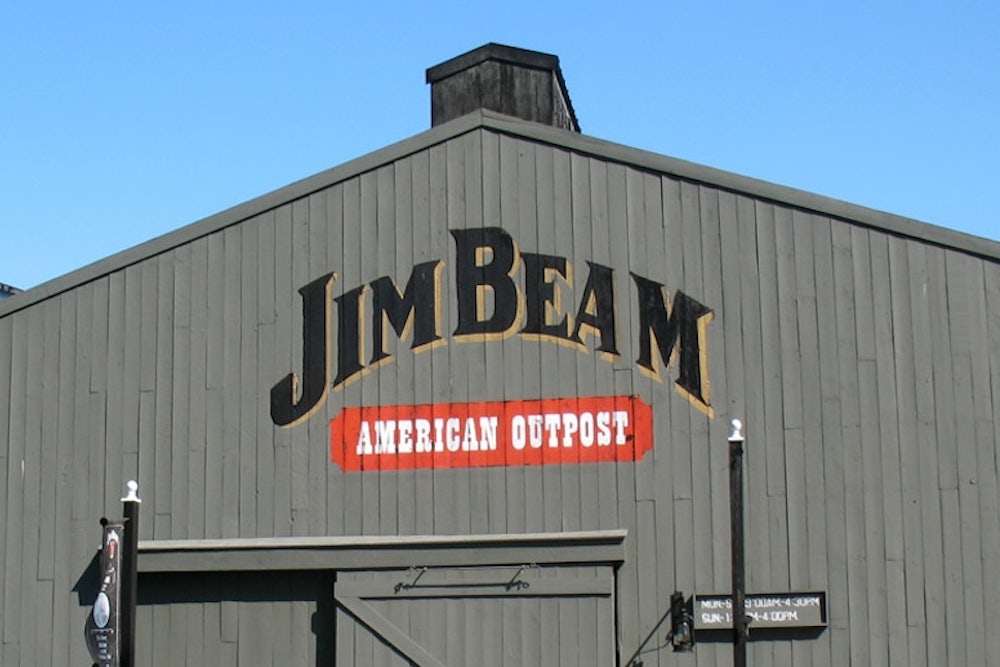When the Japanese company Suntory announced Monday that it was buying Beam Inc. for $13.6 billion, much of the bourbonsphere reacted with snark or dismay. More than a few whiskey drinkers—myself included—cast nostalgic sighs and wondered whether Jim Beam, the storied bourbon brand, would lose its American soul under the ownership of an international conglomerate that's best known in the U.S. for a fictional commercial starring Bill Murray. Others made “Suntory time!” references and bad sake jokes on Twitter. The New York Times broke the news with the maudlin headline, “My Old Osaka Home.”
But just how injurious to bourbon’s reputation could the deal turn out to be? Some historical perspective is in order.
Ownership of bourbon brands by companies outside the Bluegrass State is not only common—Britain's Diageo, Japan's Kirin, and Italy's Campari all have serious skin in the bourbon game—but also longstanding. Despite its folksy reputation, bourbon has been big business for almost two centuries, and the phenomenon of corporate consolidation coupled with “foreign” ownership has been around for nearly as long. For proof, one needn’t look further than the legendary Kentucky distiller in question: Jim Beam.
Settlers first arrived in Kentucky in the late 18th century and quickly established a tradition of using excess corn from family farms to create oak-aged corn whiskey. The practice of small-scale family distilling was soon threatened when the traditional copper pot still was rendered obsolete by the more efficient column still of the early 1800s—an expensive, unwieldy piece of industrial equipment many locally owned distilleries could not afford. The new stills brought out-of-state entrepreneurs with limited bourbon credentials, who opened commercial distilleries with which smaller, local bourbon makers struggled to compete. This tension culminated in the “Whiskey War” of the 1890s, with Kentucky’s traditional distillers and powerful distilling magnates in northern cities like Chicago and St. Louis both lobbying the government to pass legislation in their favor. The Pure Food and Drug Act of 1906 eventually settled the dispute, creating a definition for true bourbon whiskey that remains essentially unchanged to this day.
The family-owned company that began producing “Old Jake Beam” whiskey in 1795—to be renamed “Jim Beam” in 1933 —survived the whirlwind of distillery closings and consolidations that marked the Industrial Revolution and the Gilded Age, but found it considerably harder to weather the biggest storm of all: Prohibition. While a handful of distilleries were able to continue selling bourbon via a medicinal-license loophole, the Beams were unable to acquire such a permit. As smaller brands sold off their stocks and labels to the larger permit-carrying distilleries, the family tried its hand at a number of unsuccessful business ventures, including such ill-advised projects as a stone quarry and a citrus farm. By the time Prohibition was repealed in 1933, Jim Beam was in financial ruin. They, like many other bourbon distillers, had no funds to invest in making more whiskey, and no extant whiskey stock left to sell.
In the industrial cities just to the north, however, there were business interests who, despite having little experience in the bourbon arena, had the investment capital and financial acumen required to put the distilleries back in business. Jim Beam struck a deal with a trio of Chicago investors: They would take over ownership of the company, and the Beams would continue to run the distillery as they had for generations. The 1930s would see similar deals struck throughout Kentucky’s bourbon-producing counties, with ownership being handed over to corporations “foreign” to the region, while the hereditary bourbon families continued to serve as master distillers—a position many of their descendants, including a number of Beams, hold in the present day. Some have argued that the era of heavy corporate consolidation in Prohibition’s wake proved detrimental to the quality of bourbon, but this was due largely to the fact that good bourbon takes years to age, and a distillery starting totally from scratch needs to turn a profit as soon as possible. Yes, bourbon did suffer, but it was also saved from total extinction by the “foreign” ownership of its northern investors.
With this in mind, the recent sale of Beam Inc. is hardly unprecedented. Indeed, it is a story as old as bourbon itself. The $13.6 billion Suntory paid is a far cry from the $15,000 pooled by those Chicago businessmen for Beam’s original incorporation, but the bargain is essentially the same: ownership and profit-sharing from afar, in exchange for family involvement and local expertise. With Beam’s current portfolio of popular whiskeys (Jim Beam, Knob Creek, Maker’s Mark, to name a few) and six consecutive quarters of double-digit sales growth in North America, a larger holding corporation like Suntory has little reason to tinker with success.
The bourbon industry in America today is in many ways a reflection of the society that created it. Bourbon is no less susceptible to globalization than any other U.S. industry, and it's no more immune to the artisanal, small-batch backlash against international conglomeration. So if you're sad that Jim Beam is now owned by a Japanese company, there are plenty of new American craft bourbons available for you to drown your sorrows and sustain your Bluegrass cred. And some of them taste better, too.
